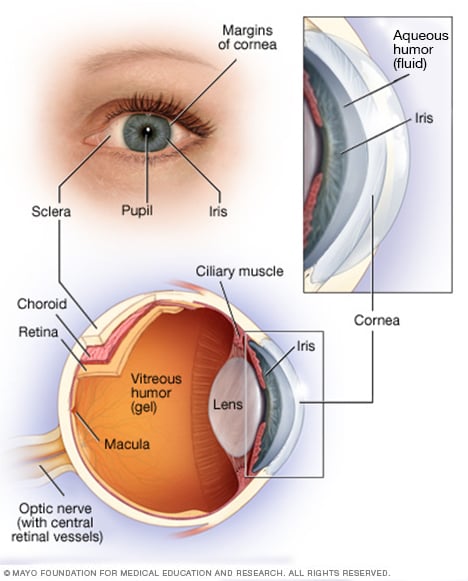Overview
Anatomy of the eye

Anatomy of the eye
Your eye is a complex and compact structure measuring about 1 inch (2.5 centimeters) in diameter. It receives millions of pieces of information about the outside world, which are quickly processed by your brain.
Retinoblastoma is a kind of eye cancer that starts as a growth of cells in the retina. The retina is the light-sensitive lining on the inside of the eye.
The retina is made up of nerve tissue that senses light as it comes in through the front of the eye. The light causes the retina to send signals to the brain. The brain interprets the signals as images.
Retinoblastoma happens most often in young children. It's usually diagnosed before age 2. It most often affects one eye. Sometimes it happens in both eyes.
There are several treatments for retinoblastoma. For most children, treatment doesn't require removing the eye to get rid of the cancer. The outlook for children diagnosed with retinoblastoma is quite good.
Products & Services
Symptoms
Retinoblastoma signs and symptoms include:
- A white color in the center circle of the eye when light is shone in the eye. It might show up in flash photos.
- Eye redness.
- Eye swelling.
- Eyes that seem to be looking in different directions.
- Vision loss.
When to see a doctor
Make an appointment with a doctor or other healthcare professional if you notice any changes to your child's eyes that concern you.
Causes
Retinoblastoma is caused by changes inside the cells in the eye. It's not always clear what causes the changes that lead to this eye cancer.
Retinoblastoma starts when cells in the eye get changes in their DNA. A cell's DNA holds the instructions that tell the cell what to do. In healthy cells, the DNA gives instructions to grow and multiply at a set rate. The instructions also tell the cells to die at a set time. In cancer cells, the DNA changes give different instructions. The changes tell the cancer cells to make many more cells quickly. Cancer cells can keep living when healthy cells would die. This causes too many cells.
In retinoblastoma, this growth of cells happens in the retina. The retina is the light-sensitive lining on the inside of the eye. The retina is made up of nerve tissue that senses light as it comes in through the front of the eye. The light causes the retina to send signals to the brain. The brain interprets the signals as images.
As the cancer cells build up in the retina, they can form a mass, called a tumor. The tumor can grow to invade and destroy healthy body tissue. In time, cancer cells can break away and spread to other parts of the body. When cancer spreads, it's called metastatic cancer. Retinoblastoma rarely spreads, especially if it's found early.
For most instances of retinoblastoma, it's not clear what causes the DNA changes that lead to cancer. However, it's possible for children to inherit DNA changes from their parents. These changes can increase the risk of retinoblastoma.
Risk factors
Risk factors for retinoblastoma include:
- Young age. Retinoblastoma is most common in very young children. It's typically diagnosed by age 2. Retinoblastoma that happens later in life is very rare.
- DNA changes that run in families. DNA variations that increase the risk of retinoblastoma can be passed from parents to children. Children with these inherited DNA changes tend to get retinoblastoma at a younger age. They also tend to have retinoblastoma in both eyes.
Complications
Children with retinoblastoma can develop complications.
Cancer that comes back
After treatment, there is a risk that the cancer might come back in the eye or near it. For this reason, your child's healthcare team will create a plan of follow-up appointments. Your child's follow-up plan will depend on the treatments your child received. A typical plan might involve eye exams every few months for the first few years after treatment.
Increased risk of other cancers
Children with the form of retinoblastoma that can run in families may have a higher risk of getting other kinds of cancer.
The risk of these cancers is increased:
- Bone cancer.
- Bladder cancer.
- Breast cancer.
- Hodgkin lymphoma.
- Lung cancer.
- Melanoma.
- Pineoblastoma.
- Soft tissue sarcoma.
Your child's healthcare team might recommend tests to screen for these other types of cancers.
Prevention
There's no way to prevent retinoblastoma.
Some retinoblastomas are caused by DNA changes that run in families. If retinoblastoma runs in your family, tell your healthcare professional. Together you might consider genetic testing to look for variations in your DNA that increase the risk of retinoblastoma. Your health professional might refer you to a genetic counselor or other healthcare professional trained in genetics. This person can help you decide whether to undergo genetic testing.
If your children have an increased risk of retinoblastoma, care can be planned to manage that risk. For instance, eye exams may begin soon after birth. That way, retinoblastoma may be diagnosed very early. These screening tests could find the cancer when it is small and has a greater chance of being cured.
If you haven't had children, but are planning to, talk with your healthcare team about your family history of retinoblastoma. Genetic testing might help you and your partner understand whether there is a risk of passing DNA variations to your future children. Your healthcare team may have options to help you manage this risk.